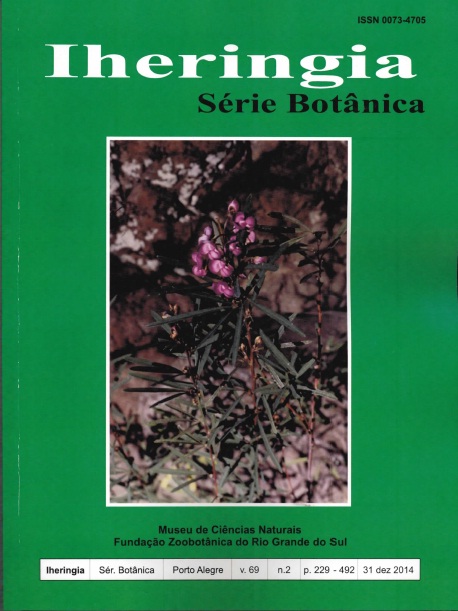Floral syndrome, resources and pollinator guilds: a case study of Heliconia psittacorum L. f. (Heliconiaceae)
Keywords:
Hesperiidae, hummingbird behaviour, nectar energyAbstract
Flower resources can affect the guilds, frequency, and behaviour of visitors. This study compared the pollinator guilds and nectar energy of Heliconia psittacorum L. f. (Heliconiaceae) during the peak and at the end of the fl owering period in a fragment of the Atlantic Forest, northeastern Brazil. Nectar production and the availability of calories were highest in the early morning, coinciding with the highest activities of fl ower visitors. Calorie availability affects pollinator guilds. During the peak of the fl owering, we recorded the hummingbirds Amazila leucogaster Gmelin (territorialist) and Phaethornis ruber Linnaeus (trapliner), the butterfl y Talides sp. (Hesperiidae), and the bee Exaerete smaragdina Guérin- Méneville. During the fi nal fl owering period, Talides sp. and the hummingbirds P. ruber and P. pretei Lesson & DeLattre were recorded. Heliconia psittacorum is an important resource in the area, and the fl ower-pollinator syndrome could not predict some of the observed pollinators.
Downloads
References
Altmann, J. 1974. Observational study of behavior: sampling methods. Behavior 49:227-267.
Brown, K.S. 1992. Borboletas da Serra do Japi: diversidade, habitats, recursos alimentares e variação temporal. In: História natural da Serra do Japi: ecologia e preservação de uma área florestal no sudeste do Brasil
(L.P.C. Morellato, ed.). Campinas, p.142-186.
Canela, M.B.F. & Sazima, M. 2003. Aechmea pectinata: a hummingbird-dependent bromeliad with inconspicuous fl owers from the rainforest in south-eastern Brazil. Annals of Botany 92:731-737.
Centro Universitário de Estudos e Pesquisas sobre Desastres - CEPED. 2011. Atlas brasileiro de desastres naturais 1991 a 2010: volume Paraíba. Centro Universitário de Estudos e Pesquisas sobre Desastres, Florianópolis. 57 p.
Cruz, D.D. 2009. Fenologia e biologia reprodutiva de Heliconia psittacorum na Reserva Biológica Guaribas. Relatório de Pesquisa – ICMBio (dados não publicados).
Cruz, D.D., Mello, M.A.R. & Van Sluys, M.V. 2006. Phenology and fl oral visitors of two sympatric Heliconia species in the Brazilian Atlantic forest. Flora 201:519-527.
Cruz, D.D., Abreu, V.H.R. & Van Sluys, M.V. 2007. The effect of hummingbird fl ower mites on nectar availability of two sympatric Heliconia species in a Brazilian Atlantic forest. Annals of Botany 100:581-588.
Dalsgaard, B., González, A.M., Olesen, J.M., Ollerton, J., Timmetmann, A., Andersen, L.H. & Tossas, A.G. 2009. Plant–hummingbird interactions in the West Indies: fl oral specialisation gradients associated with environment and hummingbird size. Oecologia 159:757-766.
Dolibana, D.R. 2011. Cumbre Evans, 1955 (Hesperiidae: Hesperiinae: Moncini): taxonomia, fi logenia e morfologia comparada Dissertação 189 f, Universidade Federal do Paraná, Paraná.
Endress, P.K. 1998. Diversity and evolutionary biology of tropical fl owers. Cambridge University Press, Cambridge. 511 p.
Faegri, K. & van der Pijl, L. 1979. The Principles of Pollination Ecology, 3rd ed. Pergamon Press, Oxford. 244 p.
Feinsinger, P. & Colwell, R.K. 1978. Community organization among neotropical nectar-feeding birds. American Zoology 18:779-795.
Feinsinger, P. 1983. Variable nectar secretion in a Heliconia species pollinated by hermit hummingbirds. Biotropica 15:48-52.
Freitas, L. & Sazima, M. 2006. Pollination biology in a tropical high-altitude grassland in Brazil: Interactions at the community level. Annals of the Missouri Botanical Garden 93:465-516.
Galetto, L. & Bernadello, G. 2005. Nectar. In: Practical Pollination Biology (A. Dafni, P.G. Kevan, B. C. Husband, eds). Enviroquest, Ontario, p. 261-312.
Harder, L.D., Jordan, C.Y., Gross, E. & Routley, M.B. 2004. Beyond fl oricentrism: the pollination function of infl orescences. Plant Species Biology 19:137-148.
Janzen, H.D. 1971. Euglossine bees as long-distance pollinators of Tropical plants. Science 171:203-205.
Johnson, S.D. & Steiner, K.E. 2000. Generalization versus specialization in plant pollination systems. Trends in Ecology and Evolution 15:140-143.
Kress, W.J. 1985. Bat pollination of an Old World Heliconia. Biotropica 17:302-308.
Lopes, A.V. & Machado, I.C. 1999. Pollination and reproductive biology of Rauvolfi a grandifl ora Apocynaceae: Secondary pollen presentation
herkogamy and self-incomaptibility. Plant Biology 1:547-553.
McDade, L. & Weeks, J.A. 2004. Nectar in hummingbirdpollinated Neotropical plants I: Patterns of production and variability in 12 species. Biotropica 36:196-215.
Ollerton, J., Alarcón, R., Wase, N.M., Price, M.V., Watts, S., Cranmer, L., Hingston, A., Peter, C.I. & Rotenberry, J. 2009. A global test of the pollination syndrome hypothesis. Annals of Botany 103:1471-1480.
Pedersen, L.B. & Kress, W. J. 1999. Honeyeater Meliphagidae pollination and the fl oral biology of Polynesian Heliconia (Heliconiaceae). Plant Systematics and Evolution 216:1-21.
Powers, D.R. & McKee, T. 1994. The effect of food availability on time and energy expenditures of territorial and non-territorial hummingbirds. The
Condor 96:1064-1075.
Ramirez, N. 2004. Pollination specialization and time of pollination on a tropical Venezuelan plain: variation in time and space. Botanical Journal of the Linnean Society 145:1-16.
Real, L.A. & Rathcke, B.J. 1991. Individual variation in nectar production and its effect on fi tness in Kalmia latifolia. Ecology 72:149-155.
Ruschi, A. 1986. Aves do Brasil. Expressão e Cultura, Rio de Janeiro. 335 p.
Silva, J.M.C. & Tabarelli, M. 2000. Tree species impoverishment and the future fl ora of the Atlantic Forest of northeast Brazil. Nature 404:72-74.
Stiles, F.G. 1975. Ecology, fl owering phenology, and hummingbird pollination of some Costa Rican Heliconia species. Ecology 56:285-301.
Stiles, F.G. 1981. Geographical aspects of bird-fl ower coevolution, with particular reference to Central America. Annals of Missouri Botanical Garden 68:323-351.
Suzuki, K., Dohzono, I. & Hiei, K. 2007. Evolution of pollinator generalization in bumblebee-pollinated plants. Plant Species Biology 22:141-159.
Taylor, J. & White, S.A. 2007. Observations of hummingbird feeding behavior at fl owers of Heliconia beckneri and H. tortuosa in southern Costa Rica. Ornitologia Neotropical 18:133-138.
Temeles, E.J. & Kress, W.J. 2003. Adaptation in a planthummingbird association. Science 300:630-633.
Temeles, E.J., Goldman, R.S. & Kudla, A.U. 2005. Foraging and territory economics of sexually dimorphic purple-throated caribs Eulampis jugularis on three Heliconia morphs. The Auk 122:187-204.
Waser, N.M., Chittka, L., Price, M.V., Williams, N.M. & Ollerton, J. 1996. Generalization in pollination systems, and why it matters. Ecology 77:1043-1060.
Wikeski, M., Moxley, J., Eaton-Mordas, A., López-Uribe, M.M., Holland, R., Moskowitz, D., Roubik, D. & Kays, R. 2010. Large-range movements of neotropical orchid bees observed via radio telemetry. PLoS ONE
:e10738.







